
Worshipful Master Bart Harvey - Secretary & Editor John "Corky" Daut
The September 2010 Issue
|
It’s Happening At Waller Lodge
By Corky
The Waller Lodge “Kitchen Remodel Project” got a huge boost last week when the Waller County Shrine Club donated 2 brand new dishwashers to Waller Lodge in appreciation for us allowing them the use of our facilities. A really big thank you to our brothers in the Waller County Shrine Club.
- - - - - - - - - - - - - - - - - -
Waller Lodge will be holding a raffle in the near future with a hunting rifle and hunting equipment as prizes to raise funds for Scholarships.
- - - - - - - - - - - - - - - - - -
A $100.00 donation was made to the Pine Island Baptist Church, in lieu of flowers, in memory of Virginia Ann Reynolds, wife of Brother Clem Reynolds and mother of Brother David Reynolds.
+ = + = + = + = + = + = + = + = + = +
SICKNESS AND DISTRESS
Please say a prayer for,
+ = + = + = + = + = + = + = + = + = +
Brother Bob Scarborough had a stent installed.
- - - - - - - - - - - - - - - - - -
Brother George Talbert had a heart valve replacement.
- - - - - - - - - - - - - - - - - -
Brother Don Price of Pleasant Hill Lodge had a quadruple heart bypass.

Brother George Washington
A Did U Know? From W. Bro. Dwight D. Seals
Submited By W. Bro. Norm Lincoln
Bro. George Washington was painted wearing a Masonic Apron by Walter Williams in 1794. Many critics claim it is the most accurate likeness of the President as it was a life painting.painting isthe possession of the Masonic Lodge of Alexandria, Virginia.
The U. S. Post Office modeled thisportraitthe nine cent stamp issued by the United States in a 1932 Commemorative Set. The stamp is printed in salmon pink with a white-line border. At the center in a large panel rectangular in shape below, oval and slightly widened in the upper portion. Above the central panel in a double curved white ribbon with scrolled ends are the words "United States postage" in dark Roman. In each lower corner of the stamp is the numeral "9" in white Roman. In a horizontal line at the base between the numerals is the word "Cents" in white Roman. On a white ribbon at the base of the portrait within the central panel is the name "Washington" in dark Roman. In the curved ends of the ribbon above the numerals are the dates "1732" at the left and "1932" at the right. Rising  | | Graphic for first day covers used by stamp collectors for the day the Washington stamp was issued. |
from each ribbon end is a small laurel branch.It is Scots #714 and the government issued 75,709,200 of this stamp.The United States Post Office Department deleted the Masonic Apron from the stamp.
The 1932 Washington Bicentennial are postage stamps issued by the United States government in 1932 to commemorate the 200th anniversary of President George Washington's birth. Twelve stamps were issued as a collection, with each one depicting the President in a different period in his life. The series was designed by the Bureau of Engraving and Printing (BEP) designers Clair Aubrey Huston and Alvin Meissner. The 1/2¢ through 10¢ values depict portraits of Washington which were derived from paintings, engravings or sculptures made during his lifetime. The selections were made based on recommendations made by the Washington Bicentennial Commission, The United States Post Office Department and the BEP. The original concept called for not only picturing Washington but also featuring significant events, locations and iconic images of his life and after death. This was later modified to featuring only portraits.
May We Meet Upon The _|_ Act By The | And Part Upon The |_
W. Bro. Dwight D. Seals
Camden Lodge #159 Camden, Ohio


Two Very Good Questions
To Test Your Judgment
Question 1:
If you knew a woman who was pregnant, who had 8 kids already, three who were deaf, two who were blind, one mentally retarded, and she had syphilis; would you recommend that she have an abortion?
Read the next question before going on down to the answer for this one.
Question 2:
It is time to elect a new world leader, and your vote counts. Here are the facts about the three leading candidates:
Candidate A: Associates with crooked politicians, and consults with astrologists. He's had two mistresses. He also chain smokes and drinks 8 to 10 martinis a day.
Candidate B: He was kicked out of office twice, sleeps until noon, used opium in college and drinks a quart of whisky every evening.
Candidate C: He is a decorated war hero. He's a vegetarian, doesn't smoke, drinks an occasional beer and hasn't had any extramarital affairs.
Which of these candidates would be your choice?
(Decide first, no peeking, then go to the bottom of this section for the answer).


Speculative Masonry In Ancient China
There is often debate as to when speculative Masonry began. Some would say that it was when the Grand Lodges were formed in the early 1700s; but research produces interesting evidence which might well change that opinion. Evidence of Masonic truths has been found in ancient Greece, in India, in Egypt and in China; and it is to China that attention is directed in this Article.
The books of ancient China contain many Masonic expressions. For example, in a book called "The Great Learning", written in 500 BC, it is stated "A man should abstain from doing unto others what he would not they should do unto him, and this is called the principle of acting on the Square".
Confucius, the great Chinese moral teacher, born about 550 BC and Mencius, his pupil, arranged an orderly system of moral teaching. From the sixth volume of the work on philosophy, I quote; "A Master Mason in teaching his apprentices, makes use of the compasses and the square. We who are engaged in the pursuit of Wisdom, must also make use of the compasses and the square".
Mencius also wrote; "Men should apply the compass morally to their lives, and the level and marking-line besides, if they would walk in the straight and even path of Wisdom, and keep themselves within the bonds on honor and virtue".
In Peking, in China, there is a place called the temple of Heaven, one of the few ancient relics of the Chinese monotheistic faith. It is constructed in the form of a square, with special seats in the east, the west and the south. There is an altar in the very center. There are three circular platforms of diameters of 90 feet, 150 feet, and 210 feet. Note that these are in the ratio of 3, 5 and 7. The temple was built in 1420, but the altar is considered to be 4000 years old.
There was a society called HUNG, or "The Brotherhood of Heaven and earth". This can be traced back to 386 AD. It had a supreme Grand Master, a Senior and Junior Warden, and many subordinate lodges. In the lodge ceremonies, the initiate knelt at the altar, with the Senior and Junior Wardens kneeling at his right and left, each holding a sword overhead to form a right angle over the candidate. The lecture given by the Worshipful Master taught that all are equal, that they must live uprightly and justly, that they must help a brother in distress, preserve his secrets, respect the chastity of his wife, and that they must obey the Worshipful Master. The three great principles of the Hung lodge were Brotherly Love, Relief and Truth.
Brethren, it is interesting to note that there has been no Masonry on mainland China for very many years, but now, in 1988, a new Lodge is being constituted there under the Irish Constitution.
Ref: Lodge of Research No.200 (1993), Grand Lodge of Ireland, and Ashlar Lodge No.247, G.R.C. (May 1993)
Editor's Note: While definite historical evidence for the Hung may not go back beyond 1662, Hwui-yin did establish his "White Lotus Society", at Rozan, south of the Yang Tze, c.376 AD. Due to persecutions of worshippers of Amitabha Buddha, the White Lotus went through a quiescent period until Han Shan-tung (1344) revitalised the Society. By the 18th century the Hung and the White Lotus are intermingled until primarily the Hung are only heard of. The White Lotus did rise up after the slaying of Su Hung-u-, and the in the proclamation of 1662. path.


| Masonic Anniversaries |
| Brother | Years |
| James B. Riley | 54 |
| Clem Reynolds | 52 |
| Maurice Tucker | 51 |
| Eric. Flanagan | 35 |
| Kenneth L. Cones | 12 |
| Happy Birthday To |
| Brother | Age |
| Richard L. James | 85 |
| James B. Haney | 78 |
| J. Fred Loofs | 74 |
| Robert J. Blackman | 63 |
| Louis Schiel | 55 |
| Michael Risley | 53 |
| John C Stalsby | 45 |
| Mitchell R. Bosarge | 38 |

"Freemasonry is founded on the immutable laws of Truth and Justice and its grand object is to promote the happiness of the human race.
[GEORGE WASHINGTON]",

Inside Asheville’s Masonic Temple
By Alyanna Sezak-Blatt
Mountain Xpress - Asheville NC
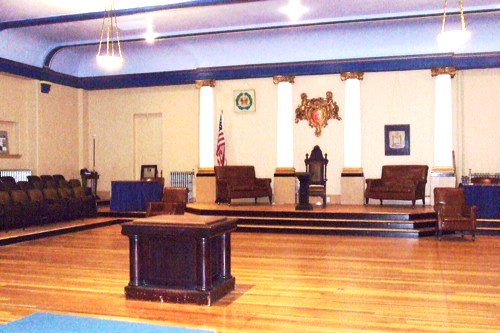 | | The Masonic Alter |
For many, the Masonic Temple at 80 Broadway in downtown Asheville is intriguing and mysterious, in part because the temple’s doors have been closed to the general public for years. That’s changed. In an effort to reconnect with Asheville’s artistic community, and to help raise money for building renovations, the temple will be hosting public events and concerts in a 270-seat auditorium/theatre within the building.
The Land of Skt Symphonic Band will perform there tonight, 20 May at 7:30 p.m. ($10 suggested donation). On 5 June, singer/songwriter and folk musician Dave Wendelin and an ensemble of guest musicians take the stage at 8 p.m. (by donation, with partial proceeds benefiting temple restorations). The auditorium may even host the Montfrod Park Players during their winter season.
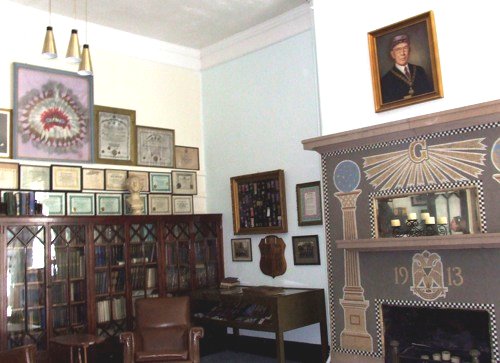 | | The Masonic Library: |
Ron Lambe, events committee chair and a 5-year Mason with the Asheville Temple, led an informal tour of the historic building, which was designed by Mason and renowned architect Richard Sharp Smith in 1913. The temple opened in 1915 and became headquarters for various branches of the Masonic order. During the tour, Lambe noted that the temple, historically, was more involved in supporting the greater Asheville community:
During the Spanish Influenza epidemic in 1918 the temple functioned as a hospital and emergency ward, and in the 1950s the building was designated as a public bomb shelter. In recent years, however, the stately building has been closed for all public use.
There are a few photographs of the temple’s auditorium, meeting/ceremony room, library, game room and various rooms used for reading and studying in the original article and on the web version of this newsletter.
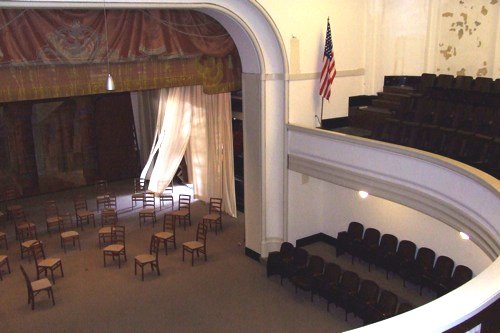 | | Views from the fourth-floor balcony: |
Seating 270 people, the auditorium is located on the third floor of the building, with a horseshoe-shaped balcony overlooking the stage from the fourth floor. This section of the Temple was occupied by the Scottish Rite, and the auditorium was once referred to as the Scottish Rite Cathedral. Painted landscapes and backdrops are stacked in the eaves of the cathedral, hung in the fly loft above the stage. These elaborate paintings, which are being stored for future use, were once used for Masonic lessons, Lambe says, where biblical stories and teachings were dramatically enacted for educational purposes.


A blonde driving down the interstate noticed a woman furiously rowing a boat at the edge of a cornfield.
She stopped and called to the woman, “Hey! What are you doing?”
The woman replied, “I’m trying to row this boat, but it isn’t going anywhere!”
The motorist called back, “You know, it’s blondes like you that give us a bad name. If I could swim, I’d come over there and beat you up!”


|
The Small Town Texas Masons E-Magazine
Don’t miss reading the monthly Small Town Texas Masons E-Magazine at, http://www.mastermason.com/STTM-Emag/
This Month features the Myra Lodge Number 878 A. F. & A. M. and Brother Sam Houston Is Gone.
|

The Golden Trowel Award
By Corky
I was wandering through some of my old Hempstead Masonic Lodge newsletters last week and found the following column. I remembered hearing Carolyn's speech that day and felt that her words deserved to be repeated.
- - - - - - - - - - - - - - - -
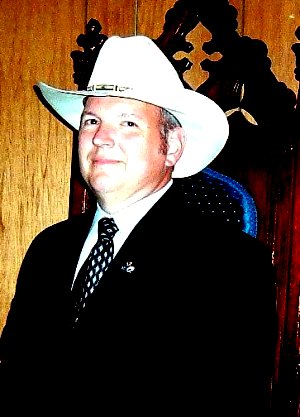 | | Past Master Mike Risley |
Brother Mike Risley of Waller Masonic Lodge #808 AF & AM received the Golden Trowel award on Saturday May 17, 2003. I would like to quickly add that Brother Mike is one Brother who truly deserves it.
Brother Mike's wife, Carolyn gave such a speech at the award, that I had to include part of it here.
"A Brothers deeds are bricks that form the structure (i.e. giving gallons of blood, changing dozens of flat tires, Driving hundreds of miles to visit sick family and friends and sitting with grieving family and friends)
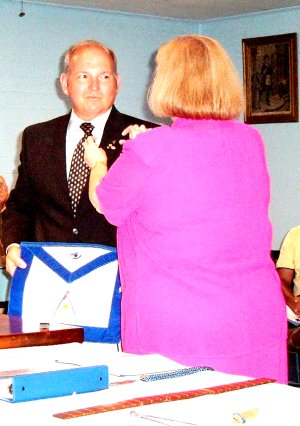 | | Mike and Carolyn Risley |
His Spirit of Humility and Compassion are the mortar's sand and cement. (never does a good deed to get a reward - only to ease other's burden; attitude always conveys feelings of respect and empathy)
His perspiration from hard work wets the sand and cement to form the mortar (never quits until the job is done.) Together the deeds, humility, compassion and perspiration form a structure that all can see is worthy of honor."
Carolyn's words are not really a part of our Masonic work, but they sure fit in well enough that they could be.


"Masonry was not made to divide men, but to unite them, leaving each man free to think his own thoughts and fashion his own system of ultimate truth. All its emphasis rests upon two extremely simple and profound principles, love of God and love of man. [J. F. NEWTON]",

This Month's Humor
A photographer from a well-known national magazine was assigned to cover the recent Southern California fires. The magazine wanted to show some of the heroic work of the firefighters as they battled the blazes.
When the photographer arrived, he realized that the smoke was so thick that it would seriously impede or make it impossible for him to photograph anything from ground-level.
So he requested permission to rent a plane and take photos from the air. His request was approved, and arrangements were made. He was told to report to a nearby airport, where a single-engine plane would be waiting for him.
He arrived at the airport and saw the plane warming up near the gate. He jumped in with his bag and shouted, "Let's go!" The pilot swung the plane into the wind, and within minutes they were in the air.
The photographer said, "Fly over the park and make two or three low passes so I can take some pictures."
"Why?" asked the pilot.
"Because I am a photographer for a national magazine," he responded, "and I need some close-up shots."
The pilot was silent for a moment; finally he stammered,
"So, you're telling me you're not the flight instructor?"


Answers To "Two Good Questons"
Candidate A is Franklin Roosevelt,
Candidate B is Winston Churchill.
Candidate C is Adolph Hitler.
And by the way: The answer to the abortion question. If you said yes to the abortion, you just killed Beethoven.
Makes you wonder dosn't it? Makes a person think before judging someone...
And remember, amateurs built the ark but professionals built the Titanic.

|
| The Waller Lodge Electronic Newsletter Subscriber's
Extra Features |
The Grand Lodge Of England
The Grand Lodge of England was formed, as the first Grand Lodge in the world, by the coming together of four London Lodges at the Goose and Gridiron Tavern, St. Paul's Churchyard on 24th June 1717. They elected Anthony Sayer, Gentleman, as the first Grand Master and resolved to meet annually at a Grand Feast.
The lodges began to attract men of intellect, notably Dr. John Theophilus Desaguliers (Grand Master 1719) and other members of the Royal Society and the aristocracy, (John 2nd Duke of Montagu, the first noble Grand Master 1721) who changed the Grand Lodge from a simple Feast to a regulatory body.
By 1730 the Grand Lodge had published its Constitutions (1723); begun to keep official Minutes (1723); issued an annual engraved List of Regular Lodges (1723); set up a Charity Committee and Central Charity Fund (1727); held authority over seventy four Lodges in England and Wales, and had begun to export the Craft abroad by issuing deputations to form lodges in Gibraltar and India.
Development at home was aided by the appointment by patent of Provincial Grand Masters to represent the Grand Master in the Counties. The success of the premier Grand Lodge was crowned in 1782 by the installation of HRH Henry Frederick, Duke of Cumberland as Grand Master.
In 1768 the premier Grand Lodge took the momentous decision to build a Hall as its headquarters in London. A site was purchased in Great Queen Street, an architectural competition held, the Foundation Stone laid, and on 23 May 1776 the Hall was formally dedicated to the purposes of Freemasonry. In addition to providing offices and meeting rooms the Hall, fronted by the Freemasons' Tavern, was to prove a popular venue for concerts, musical and literary recitals, dinners and balls during the London 'season'. Designed by Thomas Sandby (1721-1798), the Grand Hall survived until 1931 when it was found to be structurally unsound and was demolished.


Surviving The Big Ones
By John "Corky" Daut
The big ones for me were that 16 year period between the Great Depression and World War II. Being born in 1928, I grew up during the hard times between the stock market crash of 1929 and the end of World War II in 1945.
Kite flying was a very popular pastime in the spring time. The boys would try to beg ten or fifteen cents from their parents. Five or ten cents for a kite and a nickel for a ball of string. Some cheap 2 stick kites could be found for a nickel. Now if you were real lucky, you could get a quarter and buy a box kite
If that didn't work, a nickel for a ball of string would be enough and we would build a kite from sticks and brown wrapping paper or even newspaper. The Sunday Funnies were popular for home made kites because of the color, unless your family subscribed to the Houston Press (no Sunday papers). One of the most favourite home made kite covers was the slick brown paper sleeves that covered the clothes picked up at the dry cleaners. The dry cleaners didn't have plastic covers back them. The paper was light weight and strong and when opened down the seamed side, it was about 3 feet wide by 4 feet long. Plenty big enough for the kites we built without having pasted seams.
The best kite sticks were split from apple box sides or from orange crates. The box sides were about a quarter inch thick and usually cut from straight grain wood and could be split into even sized straight sticks. Most boys built 2 stick kites because they were quicker and simpler, but the 3 stick type usually flew better.
One of the supply problems was finding the cloth material you could tear up for the tail. Most mothers saved old clothing and sheets and such for quilt scraps. They may not make quilts, but they all had quilt scraps. After we begged a piece of cloth, we would tear it into strips about 1 ½ or 2 inches wide and tie the strips together to form a long tail about 10 or 12 feet long. Tied to the bottom and hanging down from the kite, it made the kit fly stable.
The more adventures boys tied razor blades on the tail and had kite fights. The idea was to manipulate your kite as close to the string of your opponent's kite as possible. Then you would drag it's tail across his string, cutting his string in the process. The last kit still flying was the winner. The bad thing about that game however, was that the losers not only lost the battle, most of the time they also lost their kites.
Model air planes that really flew were very popular during the 1930's and 1940's especially from 1941 to 1946 when every boy wanted a model of their favorite war planes. You could even buy kits at some grocery stores for as low as 10 cents.
Almost all flying models had a frame work constructed of thin (usually1/16 to 1/8 inch) square balsa wood strips and curved pieces like wing ribs cut to shape from a balsa wood plank of the same thickness. All of the curved pieces for the plane were printed on the balsa plank and you just had to cut to the line.
You would lay the full sized plans out on a large board and cover them with a wax paper to keep the glue from sticking to the paper plan. Strips of balsa would be positioned over the side view of the frame matching the plans exactly. The strips would be cut to the proper lengths and held in place on the plan with some sewing straight pins. A tiny drop of model glue would be squeezed from the tube on each joint. After the glue dried, the pins were removed and the frame side removed. Then the process was repeated to build the second side.
The sides were then joined with short lengths of the balsa strips to create a tubular fuselage. After the fuselage was finished, the parts for the wing and tail assembles were laid out on the plan and glued together. After all of the frame assembles were finished they were covered by gluing tissue paper over the frameworks and sprinkling it with water to shrink it drum tight. The tissue and exposed frame were then painted with “Airplane Dope” (a glorified fingernail pollish.)
A long rubber band (sometime 5 or 6 bands) was anchored at the rear of the fuselage with the other end hooked to the propeller shaft. You would turn the propeller backward with your finger while holding the body of the plane until the rubber band was tightly wound, maybe a hundred or two twists. Then you would release the propeller, while at the same time you gave the plane a toss forward. The energy stored in the tightly wound rubber band/s would turn the propeller fast enough to make the plane fly.
Some of the guys with larger model planes would use one of the old eggbeater type hand drills with a hook in it instead of a bit They would hook onto the front of the propeller and wind the rubber band by cranking the drill. That was the days before electric drills were almost a household appliance. 

A History of Daylight Saving Time
Daylight Saving Time is a change in the standard time of
each time zone. Time zones were first used by the
railroads in 1883 to standardize their schedules.
According to The Canadian Encyclopedia Plus by
McClelland & Stewart Inc., Canada's “[Sir Sandford]
Fleming also played a key role in the development of a
worldwide system of keeping time. Trains had made
obsolete the old system where every major cities and
regions set clocks according to local astronomical
conditions. Fleming advocated the adoption of a standard
or mean time and hourly variations from that according
to established time zones. He was instrumental in convening
an International Prime Meridian Conference in Washington
in 1884 at which the system of international standard
time — still in use today — was adopted.”
In 1918, Congress made the U.S. rail zones official under
federal law and gave the responsibility to make any
changes to the Interstate Commerce Commission, the only
federal transportation regulatory agency at the time.
When Congress created the Department of
Transportation in 1966, it transferred the responsibility
for the time laws to the new department.
The American law by which we turn our clock forward in
the spring and back in the fall is known as the Uniform
Time Act of 1966. The law does not require that anyone
observe Daylight Saving Time; all the law says is that if
we are going to observe Daylight Saving Time, it must be
done uniformly.
Daylight Saving Time has been around for most of this
century. In 1918, in order to conserve resources for the
war effort, Congress placed the country on Daylight
Saving Time for the remainder of WW I. It was observed
for seven months in 1918 and 1919. The law, however,
proved so unpopular (mostly because people rose earlier
and went to bed earlier than we do today) that the law
was later repealed.
When the country went to war again, Congress reinstated
Daylight Saving Time on February 2, 1942. Time in the
U.S. was advanced one hour to save energy. It remained
advanced one hour forward year- round until September
30, 1945.
From 1945 to 1966, there was no federal law about
Daylight Saving Time. So, states and localities were free
to observe Daylight Saving Time or not.
This, however, caused confusion — especially for the
broadcasting industry, and for trains and buses. Because
of the different local customs and laws, radio and TV
stations and the transportation companies had to publish
new schedules every time a state or town began or ended
Daylight Saving Time.
By 1966, some 100 million Americans were observing
Daylight Saving Time through their own local laws and
customs. Congress decided to step in and end the confusion
and establish one pattern across the country. The Uniform
Time Act of 1966 (15 U.S. Code Section 260a) created
Daylight Saving Time to begin on the last Sunday of
April and to end on the last Sunday of October. Any
area that wanted to be exempt from Daylight Saving Time
could do so by passing a local ordinance. The law was
amended in 1986 to begin Daylight Saving Time on the
first Sunday in April.
Starting in 2007, most of the United States and Canada observe DST from the second Sunday in March to the first Sunday in November, almost two-thirds of the year.


A Little Military Humor 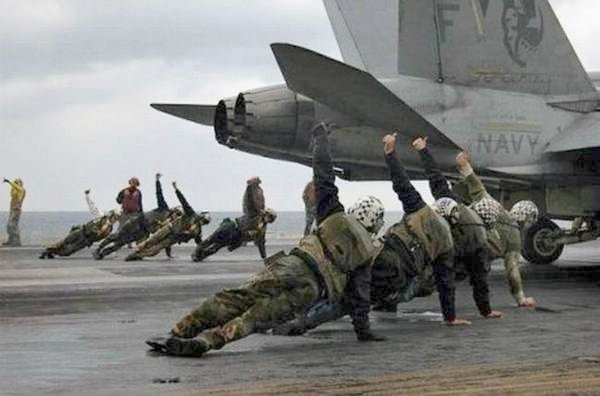
The New Cheerleaders Raise The Pilot's Morale

Did U Know? - A Century Of Ohio Masons
From W. Bro. Dwight D. Seals
Camden Lodge #159
Camden, Ohio
Brother Seals Note;
Brethren,
While surfing, I ran across this on the website of Urania Lodge #311, Plain City, Ohio. It was under "A Brief Ohio Masonic History" by W. Bro. Norman Lincoln dated 1-28-2009. This is just one paragraph of it and is an excellent job of name dropping famous Ohio Freemasons.
All names mentioned here are members of our great Fraternity so no need to go back and add Brother to the beginning of each name.
Nice job Norm.
In the 20th Century Masonry survived five wars and a Great Depression. Ohio Masons have been active in every field of human endeavor. William Cunningham and John Reeves wrote the 3 volume history which sold for $4. Barton Smith and Robert Ralston headed the Scottish Rite NJ. Eddie Rickenbacker became the leading US ace. Ralph Rickley left half a million dollars to the Masonic home. Harding and Cox ran for President. John Wyllis, W. D. Packard and Alexander Winton built automobiles. Dr. Elmer Arn was the president of the George Washington Masonic Memorial. Robert Clegg revised Mackey's Encyclopedia. John Glenn orbited the earth. Andrew White headed the Masonic Relief Association. Royal Scofield was president of the Philalethes Society. Frank Weise was the Supreme Tall Cedar. Powel Crosley, Jr. built radios, refrigerators, cars and took the Reds to the World Series. John Bricker and James Rhodes attended Grand lodge as Governor. Tad Clypool was Imperial Potentate. Vernon Stouffer sold frozen foods. Red Blaik coached Army and Weeb Eubank won the Super Bowl. Brian Donlevy and Clark Gable won Oscars and Roy Rogers was a singing cowboy. At Ohio State Howard Bevis and Novis Fawcett were president while Lynn St. John was athletic director and John Wilce was football coach and Ernie Biggs was trainer. Pete Henry made the College and Pro Hall of Fame. Karl King, Henry Fillmore and Frank Simon composed band music. Thor Johnson conducted the Cincinnati Symphony. Cliff Arquette was Charley Weaver while Clyde Beatty had a circus. Homer Rodeheaver wrote gospel hymns. Henry Busse played the trumpet and Ted Lewis the clarinet. Ken Burkhart called balls and strikes while Junior Norris made baskets for the Dayton Flyers. Wendell Willkie ran for president and Ken Blackwell for Governor. John Robinson wrote "Born in Blood". Ed Selby as General Grand High Priest started RARA. Edward Deeds founded Delco. Ray Evans won the Pulitzer Prize for cartooning. Winfred Fouse started General Tires. Fred Gruen made watches. Frank Hoover made vacuum cleaners. General Curtis LeMay bombed Japan. Norman Vincent Peale preached. Reuben Robertson and his son were president of Champion Paper. Finally Lowell Thomas left us with those famous words. "So long until tomorrow.-
May We Meet Upon The _|_ Act By The ! And Part Upon The |_ 

| Here are some of the "funnies" our grandparents enjoyed. |
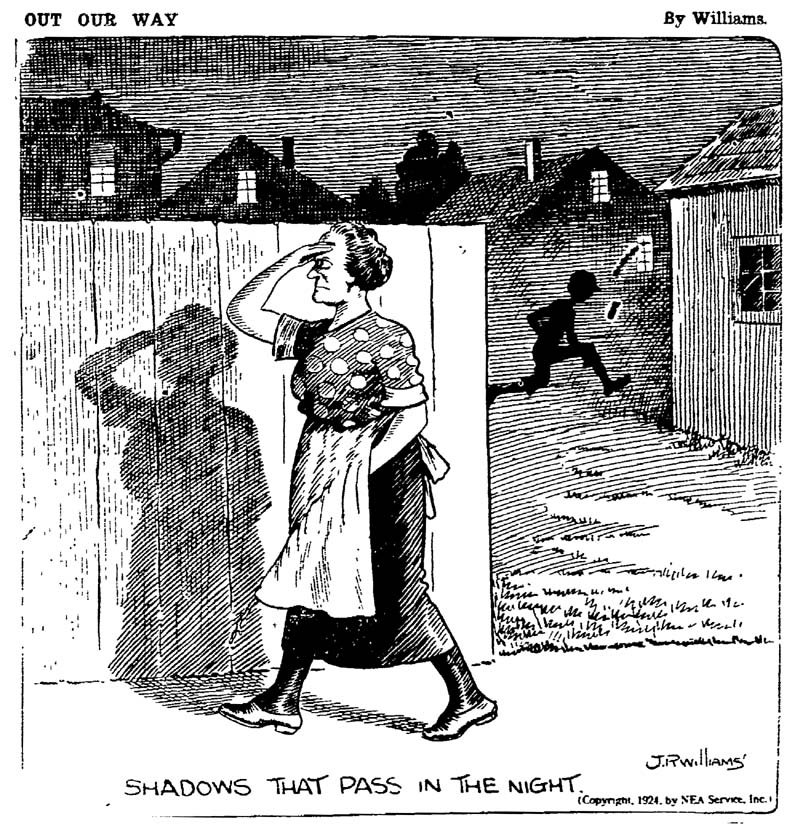

The Gift of the Magi
From the Old Tiler's Talk - by Carl H. Claudy, The Temple Publishers
What do you think happened to me in there tonight?'' asked the New Brother of the Old Tiler.
"Someone give you a dollar?" asked the Old Tiler.
''No, of course not!"
"You give someone a dollar?"
"Certainly not!"
"Well, I can't imagine what happened. Men don't usually get as excited as you are except about getting or giving dollars. What did happen?"
"Brother Smith asked me if I would stand for election as Junior Steward in December!"
"Most natural and reprehensible of Brother Smith!" chuckled the Old Tiler. "Of course you told him you would be pleased to do so."
"Why was it natural and why was it reprehensible, and of course I did nothing of the sort!" answered the New Brother.
"It Is natural for men to ask their friends if they want office. It is reprehensible, because Masonry in lodge practice is not supposed to have any politics. An election is supposed to be like a wen, something that just grows without any previous warning or conversation! But why didn't you accept with pleasure?''
"I didn't accept at all! What would I want to be an officer for?"
''Why not?''
"Why, Old Tiler, you know well enough why not! I have heard you talk before about the responsibilities of office. An officer has to serve at least seven years before he gets to the East in this lodge. He has to learn degrees and attend meetings and go to all funerals and visit the sick and labor instructing candidates and I don't know what all besides. Why should I run my head into any such noose as that? What does the officer get out of it, anyway? Nothing but fifty dollars' worth of squares and compasses to hang on a blue ribbon on his coat and for the rest of his life have some Master say, 'You are cordially invited to a seat in the East!' Not for me, thank you!"
"No, very evidently not for you," agreed the Old Tiler. "Did you tell Brother Smith all this?"
"I sure did!"
"What did lie say?"
"He didn't say anything. He just looked shocked!"
"I can understand that," mused the Old Tiler, placidly. "Most men are shocked when they go to a friend to do him honor and make him the priceless gift, and he laughs in their faces arid calls their gift trash."
''Say, hold on a minute! What are you talking about? He didn't try to give me anything. He tried to wish something on me. He tried . . .
"Oh, no, he didn't!" contradicted the Old Tiler. "You are laboring under a misapprehension. You evidently think a lodge has to beg members to be her servants. Such is not the case. The lodge looks around to see which of her sons she will honor. Through a few men she picked on you. Brother Smith came to you with the Gift of the Magi in his hands. Of course, the gift is not his to make, it is the lodge’s to make. But just because there is, now and then, the unappreciative, non-understanding member, who would tread on pearls if they were thrown before him, to get at the swill of ease and luxury instead of the jewels of labor and their reward, the lodge allows certain of its brethren to sound out the others before it offers them the position by in election.
"The lodge looks upon the election to the junior end of the line as a signal honor. In all probability, the man elected Junior Steward this year will be the Master seven years hence. At least he can be, if he has ability and love for Masonry and sticks to his job. So the lodge feels that in saying to a brother 'you may be a Master in seven years; at least, we will trust you to try, as we will try you in trust,' it is paying him the greatest compliment outside of an actual election to the East which it can pay. As betrothal is to marriage, so is election to the foot of the line to the Mastership.
''To be Master of a lodge is a position of responsibility. It means work. It means effort. It means trials. It means difficulty. But it also means much in education, in assurance on one's feet, in knowledge of character and strength of will and wit. Being Master brings great rewards, of which your 'fifty dollars' worth of gold' is but the symbol, not the substance.
"But we all make mistakes, and Brother Smith and I both made one. When he asked me about you, I said you had good stuff in you. So he spoke to you, but you don't want to bring it out for the lodge. That's your business. It was our error. So we will take the better man.''
''Why . . . Why didn't you take the better man in the first place?'' asked the New Brother.
"Oh, we didn't know he was the better man until you told us so. You had concealed it from us. We thought you had Master's quality in you. Willingness to serve, love of your fellows, desire to be something in Masonry for what it will do for you and what you can do for others; these make a Master's quality. But we were mistaken."
"No, I was mistaken," cried the New Brother remorsefully. "Do you suppose I could unconvince Brother Smith?"
"Not this year," answered the Old Tiler. "You have a year to try.


Back To Index Page
No © Copyright. Free To Use. |
|

